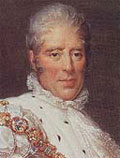 |
Charles X
b. 9 Oct 1757, Versailles, France
d. 6 Nov 1836, Goritz, Austrian Empire |
| Title: |
Par la grâce de Dieu, Roi de France et de Navarre (By the Grace of God, King of France and Navarre) |
| Term: |
16 Sep 1824 - 2 Aug 1830 |
| Chronology: |
16 Sep 1824, succeeded his brother, Louis XVIII [1, p. 137] |
|
29 May 1825, consecrated and crowned, Notre-Dame Cathedral, Reims [1, p. 138] |
|
30 Jul 1830, ceased to exercise royal
functions de facto, reign has de facto come to an end, power being
exercised by the revolutionary authorities [1, pp. 159-163] |
|
2 Aug 1830, signed a letter of abdication, Rambouillet [1, pp. 168-170], [2] |
| Names/titles: |
Private name: Charles-Philippe de France; baptized as: Charles-Philippe [19 Oct 1761]; styled: fils de France, comte d'Artois (count of Artois) [from birth], Monsieur [1795-1824]; duc et pair et comte d'Auvergne, duc et pair d'Angoulême, comte et vicomte de Limoges, duc et pair de Mercœur [from 16 Nov 1773]; in exile: Lieutenant général du royaume (Lieutenant General of the Kingdom) [from 28 Jan 1793]; used the name of comte de Ponthieu as quasi-incognito style after his abdication [after 2 Aug 1830] |
|
Lieutenant général du royaume [Lieutenant General of the Kingdom] (14 Apr 1814 - 3 May 1814) [see details] |
| Biography: |
| The fifth son of Louis-Ferdinand de France, dauphin de Viennois, and of Maria Josepha Carolina Eleonora Franziska Xaveria, princess of Saxony (French: Marie-Josèphe-Caroline-Éléonore-Françoise-Xavière); grandson of King Louis XV and brother of kings Louis XVI and Louis XVIII; did not receive any formal education; was not active in politics, leading an idle life at the court; was one of the first émigrés to leave France (17 Jul 1789); lived in Italy, Germany and Great Britain (1789-1814); proclaimed lieutenant general of the kingdom (28 Jan 1793) by the Declaration of Hamm; became heir presumptive after his brother, Louis-Stanislas-Xavier, comte de Provence, was proclaimed (24 Jun 1795) king in exile; made an unsuccessful attempt to land in the Vendée to lead a royalist rising (1795); returned to France to accept the title of lieutenant general of the Kingdom (14 Apr 1814 - 3 May 1814); set up the provisional council of state; signed the armistice with the Allies (23 Apr 1814), resulting in reduction of the territory of France within the borders, which existed in 1792; appointed colonel general of the National Guards (13 May 1814) and colonel general of the Swiss Guards (15 May 1814); emerged as the leader of the ultra royalists during the Second Restoration; succeeded Louis XVIII as King of France and Navarre (16 Sep 1824); governed with the support of reactionary governments; promulgated laws on death penalty for sacrileges and compensations for former émigrés; imposed restrictions on the freedom of press and restored censure; dissolved (16 May 1830) the Chambre des députés (Chamber of Deputies), which denounced the ministry of Prince de Polignac; following the victory of the opposition at parliamentary elections, dissolved the newly elected Chamber, restricted suffrage and abolished the liberty of the press (25 Jul 1830); was forced to abdicate (2 Aug 1830) in the course of popular revolt in Paris (Les Trois Glorieuses); resided in Scotland (until the end of 1832) and Bohemia. Biography source: [3, vol. X, pp. 718-723] |
| |
| [1] |
"Gouvernements, ministères et constitutions de la France de 1789 a 1895", by Léon Muel (Paris: Librairie Guillaumin et Cie, 1895). |
| [2] |
A letter dated Rambouillet, ce 2 août 1830 was addressed to Louis-Philippe duc d'Orléans and was signed by King Charles X and dauphin Louis-Antoine. The king abdicated in favor of his grandson, Henri-Charles-Ferdinand-Marie-Dieudonné duc de Bordeaux, whose proclamation was rejected by national legislature. Dauphin Louis-Antoine renounced his right to succession in favor of Duc de Bordeaux, who his nephew. |
| [3] |
La grande encyclopédie: inventaire raisonné des sciences, des lettres et des arts, ed. by Berthelot, Hartwig Derenbourg, F.-Camille Dreyfus... [et al.] (Paris: H. Lamirault, 1885-1902). |
|
Image: portrait by François, baron Gérard (1825) . |

